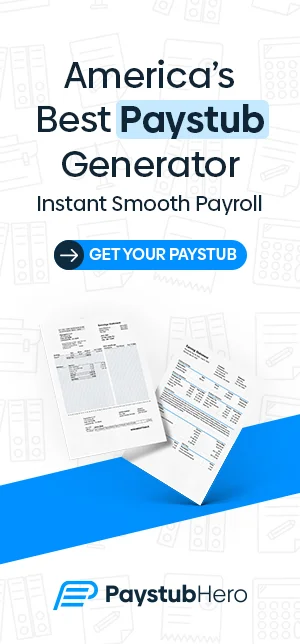Your last pay stub of the year tells the full story of your year at work. It shows how much you earned, how much was taxed, and what was taken out for things like benefits.
In this guide, I’ll break down what you’ll find on a year-end pay stub, why it’s important, and how to read it.
What Is a Year-End Pay Stub?
Your year-end pay stub is the final pay stub you get in a calendar year. It may be labeled as the last pay period of the year or simply tagged as “Final Pay Stub.”
It summarizes:
⦿ Total wages you earned this year
⦿ All taxes withheld
⦿ Deductions for benefits like health insurance or retirement
⦿ Your net pay (what actually hit your bank account)
You’ll want to hang on to this document.
Why You Should Actually Read It
Most people glance at their last pay stub and toss it in a drawer. But here’s why you should take a minute:
It Helps You Prep for Tax Season
When tax time rolls around, your last pay stub can really help. It shows what you earned and what was taken out. You can line it up with your W-2 and make sure everything matches.
If something’s off, you’ll catch it before it becomes a problem.
It Shows How Much You Really Made
You might’ve been hired at a certain salary, but that’s not what you took home. Your year-end pay stub shows what actually hit your bank account after taxes and other deductions came out.
It’s the real number you lived on all year, and that’s good to know.
It’s Proof of Income
Need to apply for an apartment, car loan, or anything that checks your income? Your final pay stub works as proof. It shows your total earnings for the year, all in one place.
It’s easy to hand over while you wait for your W-2 to show up.
You Can Spot Benefit Usage
This is where you see what you really paid for things like health insurance or your 401(k). It’s all listed on that last stub.
You can check if it lines up with what you expected and figure out if you want to make changes next year.
What You’ll See on It
Each employer may present it a bit differently, but most include:
|
Line Item |
Description |
Sample Amount |
|
GROSS PAY |
Total earnings before deductions |
$52,000 |
|
FEDERAL TAX |
Federal income tax withheld |
$4,800 |
|
STATE TAX |
State income tax withheld (if applicable) |
$1,200 |
|
FICA-SS |
Social Security tax (6.2%) |
$3,224 |
|
FICA-MED |
Medicare tax (1.45%) |
$754 |
|
401(k) |
Retirement plan contributions |
$3,000 |
|
MEDICAL INS |
Medical insurance premiums |
$1,800 |
|
NET PAY |
What you actually received |
$37,222 |
These are Year-To-Date (YTD) totals. They reflect your cumulative data for the full year.
How Does This Compare to My W-2?
Your year-end pay stub and your W-2 should mostly match, but they’re not exactly the same.
⦿ Your pay stub shows everything, including pre-tax deductions.
⦿ Your W-2 shows your taxable income after pre-tax benefits are removed.
So, if your gross pay is $52,000 and you contributed $3,000 to a 401(k), your W-2 Box 1 will likely say $49,000.
Tip: Always cross-check your last pay stub with your W-2. If something looks off, talk to payroll before filing your taxes.
Questions to Ask Yourself When Reading It
Ask these as you scan your year-end stub:
⦿ Does the YTD Gross Pay match what I expected to earn?
⦿ Are all my taxes and withholdings accounted for?
⦿ Did I max out any benefits, like a 401(k) or HSA?
⦿ Do the net pay totals make sense?
⦿ Were any bonuses or commissions included?
If anything looks off, now is the time to fix it, before tax forms go out.
What Can You Learn From This?
Well,
1. You Might Be Paying More in Taxes Than You Thought
Compare gross pay to net pay. That difference? That’s what taxes, insurance, and benefits are costing you.
2. Your Benefits Are a Bigger Deal Than You Realize
Your 401(k), medical plan, FSA, and other perks are often pulled from your check before taxes. That’s great for tax savings, but you need to know what you’re contributing.
3. It’s the Best Snapshot of Your Financial Year
This one page can show you:
⦿ Your real take-home income
⦿ How much you saved
⦿ How much you paid in taxes
That’s valuable info for budgeting, setting goals, or negotiating a raise.
Common Mistakes People Miss
⦿ Forgetting that pre-tax deductions lower your taxable wages
⦿ Thinking gross pay = net pay (it never does)
⦿ Not spotting under-withholding (which can mean a tax bill later)
⦿ Ignoring the YTD PTO usage (which some stubs show)
⦿ Not keeping a copy for your records
Don’t Have a Year-End Pay Stub? Here’s What to Do
Not all companies hand out a separate “year-end” version, but your final stub of the year usually serves the same purpose.
If you need one:
⦿ Log into your payroll portal
⦿ Contact your HR or payroll department
⦿ Ask specifically for your final stub from December
Or,
Make It Easy With PaystubHero
Want to generate clean, easy-to-read pay stubs for your records or employees?
PaystubHero lets you:
➼ Create year-end pay stubs in minutes
➼ Track YTD earnings and deductions automatically
➼ Keep accurate records for taxes, compliance, or personal budgeting
No confusing codes. No messy layouts. Just the info you need.
Perfect for small business owners, freelancers, or anyone who needs solid proof of income.
FAQs
Here are the most common questions about year end pay stubs.
No. Your final pay stub shows all income, including pre-tax deductions. Your W-2 reports only taxable income.
Bring it up with payroll or HR immediately. Fixing it now is easier than fixing a tax mistake later.
It’s helpful for reference but don’t file taxes based only on your stub. Use the official W-2 form.
Yes. Keep your year-end pay stub for at least 3 years. It’s useful for taxes, applying for loans, and tracking your financial history.
Ask your employer or payroll provider for a reprint. If you use a tool like PaystubHero, you can recreate one based on your records.




